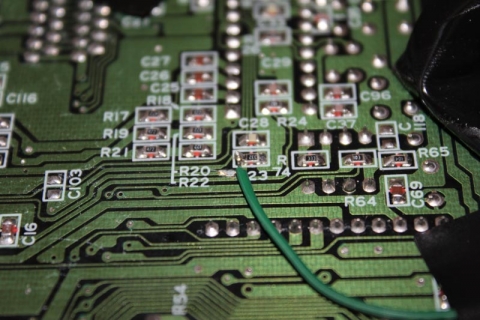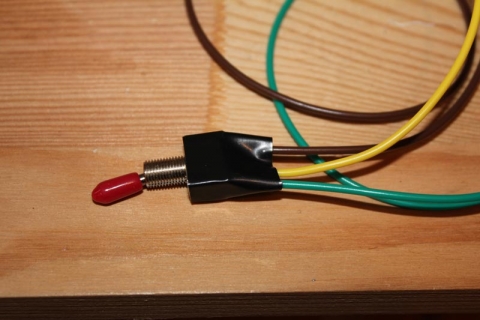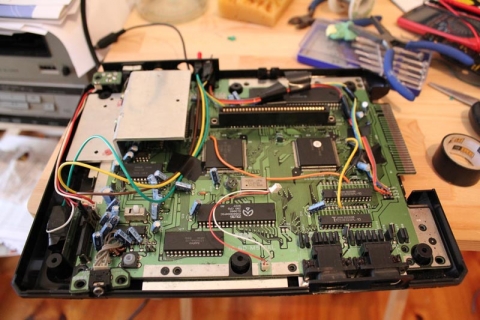Adding a switch to the 60hz colour mod
Last year I wrote a guide to get colour video out of your Mega Drive via s-video, composite and RF cables, but I’ve noticed that since using the RGB to component transcoder, the colour was flickering on my CRT I play my Mega Drive on. I tested it on our flat panel TV, and sure enough there’s some extra noise in the picture when running the SMD with the external oscillator. So, I figured I’d make a switch to go between the original feed from the Mega Drive and the oscillator, which gives the best flexibility if ever I use the SMD via s-video or composite if I’m not hooking it up via RGB/component.
The theory is simple – grab a SPDT (single pole, double-throw) switch, wire the middle (output) pin to where we used to put the oscillator’s output, wire the oscillator to one of the remaining sides and grab the existing feed off the mainboard and wire that to the other. To help out, here’s what I did:
Equipment needed:
- Remember to read this one in conjunction with the previous mod and have the oscillator ready to go!
- Two wires of a length suitable for mounting the switch (remember you’ll only need two as the existing output wire off your oscillator will be fine for adding to the switch, unless you need to lengthen it, then you should replace it)
- SPDT (single pole, double throw) switch
- Solder, soldering iron, screw driver and drill/drill bits for mounting the switch
Disclaimer
You mod your machine at your own risk. Myself nor anyone else is responsible for YOU modding YOUR Mega Drive/Genesis. If your machine doesn’t work as a result of this, don’t blame me – you do this mod at your own risk.
Step one:
Obviously, discharge and disassemble your Mega Drive and remove the mainboard and have it facing up. Be careful you don’t damage the wires hooking the oscillator you fitted from the previous tutorial.
Step two:
As per the previous mod, here’s the input signal being fed from the external oscillator into the CXA1145 IC. We’ll need to remove this to replace it with the switch’s output so we can select between the original and oscillated frequencies.
Step three:
Here we have a SPDT (single pole, double throw) switch wired up and ready to go. The middle (yellow) wire goes to the CXA1145 IC’s input, which is where we used to send the oscillator if you followed the previous mod; the green wire is from the external oscillator, and; the brown wire will take the original feed from the Mega Drive’s mainboard for RGB compatibility.
Step four:
This shows the middle (yellow) wire from the switch wired to where we used to put the oscillator. It functions as the output from the switch’s two sources.
Step five:
I’ve highlighted a point on the underside of the mainboard where you can easily solder a wire to connect to carry the Mega Drive’s original frequency to give RGB compatibility.
Step six:
To ensure I only wire the correct signal, I use some electrical tape to isolate the solder point.
Step seven:
Tin the tip, heat some solder and attach one of the wires from your switch’s input poles to the point. I’ve used the brown wire.
Step eight:
If you haven’t done so already, grab the output from the oscillator and wire it to the other side of the switch. If the wire isn’t long enough to reach to where the switch will be mounted, remove it and use another wire – it’s best to avoid joining wires together part-way along the oscillator’s input to ensure the signal remains strong and steady.
Step nine:
And that’s all there is to it – use the output from the oscillator (green) and attach that to the other side of the switch, secure your connections with electrical tape, and get ready to assemble. For those interested, the black wire at the top of the mainboard in this pic is a hardwired composite socket I built so that I could use standard AV cables with my Mega Drive.
Step ten:
I wanted to keep everything on the back of the unit, but placed in a way that would allow for the Power Base Converter to still be hooked up, so I installed the switch next to the 60/60hz and JP/Eng language switches which are next to the AV socket, where the Ext. socket would be if I had an earlier-model Mega Drive 1.
All in – would be great if I’d lined up those holes a little nicer though! Once I had the switch installed, I found I was no longer getting any issues with my Mega Drive when running it in RGB via the transcoder, so if you intend to run the machine in RGB at some stage, fit the switch!












